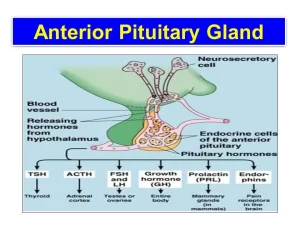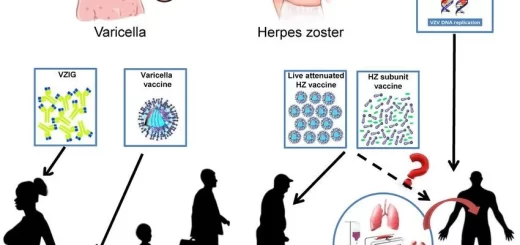Regulation of Growth Hormone Secretion and Effects of Deficiency of Anterior Pituitary Hormones
Growth hormone (GH) is also called somatotropin or human growth hormone, a peptide hormone secreted by the anterior lobe of the pituitary gland. It stimulates the growth of all tissues of the body, including bone. Growth hormone is important in human development. It is a peptide hormone that stimulates growth, cell reproduction, and cell regeneration in humans and other animals. Growth hormone antagonizes (opposes) the action of insulin.
Regulation of Growth Hormone Secretion
A) Hypothalamic control:
Secretion of growth hormone is controlled by two factors secreted in the hypothalamus and transported to the anterior pituitary, these are:
- Growth H. releasing H. (GHRH) which increases growth hormone secretion.
- Growth H. inhibiting H. (GHIH) also called somatostatin which inhibits growth hormone secretion.
B) Feedback control:
When the growth H. level increases in the blood, it reduces the rate of growth H. secretion from the pituitary gland. This is called negative feedback control.
C) Stimuli which increase GH secretion:
- Hypoglycemia is a potent stimulus for growth hormone secretion e.g starvation.
- Increased blood levels of certain amino acids (e.g. arginine) stimulate GH secretion.
- Decrease F.F.A concentration in the blood.
- Deep sleep due to its anabolic effect.
- Moderate and severe exercise, stress due to trauma, fever, surgery, anesthesia can increase the hypothalamic control of growth hormone secretion.
Effects of Deficiency of Anterior Pituitary Hormones
A) In adult
The effects of hypofunction in adults may be partial or complete:
i) Partial pituitary insufficiency:
The first function to be impaired is the secretion of the GH. If more of the gland is destroyed, GnTH secretion decreased then TSH, and lastly if the entire gland is destroyed adrenal insufficiency is detected.
ii) Complete pituitary insufficiency (panhypopituitarism):
This is the generalized failure of the anterior pituitary gland (panhypopituitarism). It is characterized by:
- Manifestations of decreased production of thyroid hormone (Hypothyroidism).
- Manifestations due to decreased production of glucocorticoids by the adrenal glands.
- Manifestations due to suppressed secretion of the gonadotropic hormone.
- Severe pallor (due to anaemia).
- Loss of weight due to anorexia (loss of appetite) and lack of the anabolic effect of the GH.
- Premature senility, this is caused by decreased GH which decreases protein dec deposition in most tissues, leading to wrinkling of the skin, diminished muscular mass and muscle strength, and diminished functions of some organs.
B) During childhood:
The deficiency of growth hormone affects the growth of all tissues of the body, so, the rate of development is greatly decreased.
- Retardation of skeletal growth (short stature) so, a child who has reached the age of 10 years may have the bodily development of a child of 4 to 5 years. However, the features of the body develop in appropriate proportion to each other, but the rate of development is greatly decreased (dwarf)
- The growth of soft tissue is retarded, the metabolic rate is lowered.
- There is no mental retardation (no effect on the development of the nervous system).
- The entire body is so small that only small quantities of thyroid-simulating and adrenocotictrophic H. are needed, so, there are no manifestations of thyroid deficiency or adrenocortical deficiency.
- In one-third of the patients, the deficiency is of growth H. alone. These individuals mature sexually.
- Two-thirds of dwarfs have an insufficient quantity of gonadotropic H. to develop adult sexual function so; these patients suffer from hypogonadism. If the child suffers only from deficiency of GH the condition is known as Dwarfism, but if he suffers from a deficiency of GnTH in addition to GH, the condition is known as infantilism.
Effects of hypersecretion of GH
A) during childhood (before the union of epiphyses):
Hypersecretion of GH during childhood will lead to:
- Increase rate of growth of all body tissues (soft tissues and skeleton).
- Increase growth of bones as the epiphyses of the long bones do not become fuse with the shafts. This will lead to an increase in the height of the child which may reach 8-9 feet (Giant).
- Increase blood glucose level (hyperglycemia). The beta cells of the islets of Langerhans in the pancreas are degenerated from excessive stimulation due to hyperglycemia.
- Infantile gonads (due to pressure on the gonadotropic cells by the tumor which leads to decrease secretion of GnTH).
Most giants, unfortunately, develop partial hypopituitarism if they remain untreated due to exhaustion of the gland at terminal stages. This general deficiency of pituitary H. usually causes death in early adulthood.
B) during adulthood (after union of epiphyses):
Increase growth H. after adolescence will lead to:
- Increase the thickness of long bones as the bone can grow in thickness but not in length so the person can’t grow taller, It can cause disproportionate growth of the thickness of the long bones.
- Overgrowth of the membranous bones which have no epiphysis to unite, including the cranium, the nose, the bosses on the forehead, the supraorbital ridges, and the lower jaw bone. So, the jaw protrudes forward, the forehead slants forward because of excess development of the supraorbital ridges, the nose increases twice normal size.
- Marked enlargement in the small bones of the hands and feet (acral parts). that is why the condition is known as acromegaly. The foot requires a larger shoe, the fingers become extremely thickened so that the hand develops a size almost twice normal.
- Enlargement of the vertebrae ordinarily causes hunches back (kyphosis).
- Overgrowth of soft tissue and viscera. such as the lips, tongue, nose, scalp, liver, heart, and kidneys.
- The skin becomes coarse and thick. the body hair is increased in amount.
- Hyperglycemia is due to the diabetogenic effect of GH and 25% of patients develop diabetes mellitus. This condition is known as acromegaly.
Prolactin
It is a protein hormone secreted from the anterior pituitary, It is also called lactogenic hormone (LTH).
Functions of Prolactin
- It causes milk secretion from the breast.
- It stimulates the synthesis of fat and lactose in the mammary gland.
- It inhibits the effects of gonadotropin on the ovary so ovulation inhibited producing amenorrhea during lactation.
- The function of prolactin in males is unknown.
Regulation of Prolactin secretion
I) Hypothalamic regulation:
- Prolactin-releasing hormone from the hypothalamus stimulates prolactin secretion.
- Prolactin is inhibited by the hypothalamic-inhibiting hormone which is released from the hypothalamus. It is chemically dopamine so; the drugs that increase the formation of dopamine as (L-dopa) reduce prolactin secretion and drugs that block dopamine receptors increase prolactin. In normal conditions, prolactin secretion is tonically inhibited indicating that the effect of PrIH normally overbalances the effect of PrLRH.
Il) Negative feedback regulation: Prolactin facilitates the secretion of dopamine (PIH) from the hypothalamus, thus acting by a negative feedback mechanism to inhibit its own secretion.
III) Effect of sleep: Plasma prolactin level increases during sleep.
IV) Other factors: Prolactin secretion increased by exercise, surgical and psychological stresses, and stimulation of the nipple through suckling reflex.
Effects of hypersecretion of prolactin
Excess prolactin in the blood leads to:
- Galactorrhea.
- Amenorrhea in women is caused by blocking the action of gonadotropin on the ovaries.
- Impotence in male which disappears when prolactin secretion is reduced.
You can follow science online on YouTube from this link: Science online
Anterior pituitary gland function, hormones, location and Effects of Growth Hormone
Pituitary gland function, structure, location, hormones and anatomy
Endocrine system structure, function, disorders, Endocrine Glands and Hormone types
Endocrine system, Endocrine glands, Pituitary gland and Hormonal coordination in living organisms
Adrenal ( suprarenal ) glands, Pancreas and Sex glands (Gonads)
Posterior pituitary gland hormones & function, Control of ADH and Oxytocin hormone




